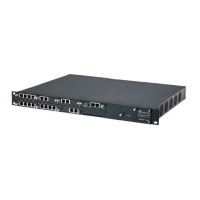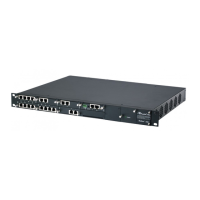User's Manual 190 Document #: LTRT-27055
Mediant 1000B Gateway & E-SBC
with adaptations (see ''Fax / Modem Transparent with Events Mode'' on page 196)
Transparent: passing the fax / modem signal in the current voice coder (see ''Fax /
Modem Transparent Mode'' on page
196)
RFC 2833 ANS Report upon Fax/Modem Detection (see ''RFC 2833 ANS Report
upon Fax/Modem Detection'' on page
197)
‘Adaptations’ refer to automatic reconfiguration of certain DSP features for handling
fax/modem streams differently than voice.
14.2.2.1 T.38 Fax Relay Mode
In Fax Relay mode, fax signals are transferred using the T.38 protocol. T.38 is the ITU
standard for sending fax across IP networks in real-time mode. The device currently
supports only the T.38 UDP syntax.
T.38 can be configured in the following ways:
Switching to T.38 mode using SIP Re-INVITE messages (see ''Switching to T.38
Mode using SIP Re-INVITE'' on page
190)
Automatically switching to T.38 mode without using SIP Re-INVITE messages (see
''Automatically Switching to T.38 Mode without SIP Re-INVITE'' on page
191)
When fax transmission ends, the reverse switching from fax relay to voice is automatically
performed at both the local and remote endpoints.
You can change the fax rate declared in the SDP, using the 'Fax Relay Max Rate'
parameter (FaxRelayMaxRate). The parameter does not affect the actual transmission
rate. You can also enable or disable Error Correction Mode (ECM) fax mode using the 'Fax
Relay ECM Enable' parameter (FaxRelayECMEnable).
When using T.38 mode, you can define a redundancy feature to improve fax transmission
over congested IP networks. This feature is activated using the 'Fax Relay Redundancy
Depth' parameter (FaxRelayRedundancyDepth) and the 'Fax Relay Enhanced
Redundancy Depth' parameter (FaxRelayEnhancedRedundancyDepth). Although this is a
proprietary redundancy scheme, it should not create problems when working with other
T.38 decoders.
14.2.2.1.1 Switching to T.38 Mode using SIP Re-INVITE
In the Switching to T.38 Mode using SIP Re-INVITE mode, upon detection of a fax signal
the terminating device negotiates T.38 capabilities using a Re-INVITE message. If the far-
end device doesn't support T.38, the fax fails. In this mode, the 'Fax Transport Mode'
parameter (FaxTransportMode) is ignored.
To configure T.38 mode using SIP Re-INVITE messages:
1. Open the Gateway General Settings page (Setup menu > Signaling & Media tab >
Gateway folder > Gateway General Settings), and then from the 'Fax Signaling
Method' drop-down list (IsFaxUsed), select T.38 Relay:
Figure 14-4: Configuring Fax Signaling to T.38
2. On the Fax/Modem/CID Settings page, configure the following optional parameters:
• 'Fax Relay Redundancy Depth' (FaxRelayRedundancyDepth)
• 'Fax Relay Enhanced Redundancy Depth'
(FaxRelayEnhancedRedundancyDepth)
• 'Fax Relay ECM Enable' (FaxRelayECMEnable)
• 'Fax Relay Max Rate' (FaxRelayMaxRate)

